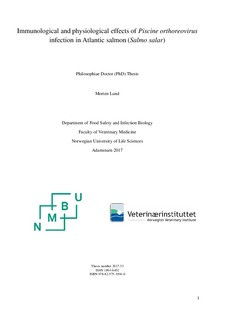| dc.contributor.advisor | Dahle, Maria K. | |
| dc.contributor.advisor | Rimstad, Espen | |
| dc.contributor.advisor | Aspehaug, Vidar | |
| dc.contributor.author | Lund, Morten | |
| dc.date.accessioned | 2018-05-14T11:06:06Z | |
| dc.date.available | 2018-05-14T11:06:06Z | |
| dc.date.issued | 2017 | |
| dc.identifier.uri | http://hdl.handle.net/11250/2498056 | |
| dc.description.abstract | Heart and skeletal muscle inflammation (HSMI) is an important viral disease in Norwegian farmed Atlantic salmon (Salmo salar), and was associated with Piscine orthoreovirus (PRV) in 2010. Recently, the causality between PRV and HSMI was confirmed in Atlantic salmon experimentally infected with purified virus. Two important features of PRV infection are that erythrocytes are the most common target cell and the development of severe cardiac inflammation. Furthermore, the main function of erythrocytes and the heart is to transport oxygen (O2) and carbon dioxide (CO2) to and from metabolically active tissues. PRV is ubiquitously present in seawater-reared farmed Atlantic salmon in Norway, and the majority of HSMI outbreaks occur in the seawater grow-out phase. However, PRV infection also occur in freshwater reared pre-smolts, and HSMI outbreaks in pre-smolt facilities have been reported. The severity of HSMI outbreaks varies, and as for other infectious diseases, the outcome of PRV infection is influenced by agent-, host- and environmental factors. For example, handling of the fish and episodes of hypoxic seawater caused by environmental factors are common during the grow-out phase of the production cycle of Atlantic salmon. Little is known about the effects of PRV infection on hypoxia tolerance, or the side effects of additional stressors on HSMI development. The seawater-reared farmed Atlantic salmon are constantly exposed to numerous pathogens and co-infection of viruses is common. PRV-infected Atlantic salmon induces a long-lasting systemic antiviral immune response, which may affect the outcome of a secondary virus infection. Pancreas disease is caused by salmonid alphavirus (SAV) and is prevalent in Norwegian aquaculture in the southern half of the coastline. PRV and SAV have been co-detected in seawater farmed salmon and share target organs like the heart and skeletal muscle. This thesis aimed to elucidate some of these interactions by performing two challenge trials on PRV-infected Atlantic salmon. | nb_NO |
| dc.description.abstract | Hjerte og skjelettmuskel betennelse (HSMB) er en viktig virussykdom i Norsk oppdrett av Atlantisk laks (Salmo salar) og ble assosiert med Piscine orthoreovirus (PRV) i 2010. Wessel og medarbeidere bekreftet nylig årsakssammenhengen mellom PRV og HSMB i Atlantisk laks eksperimentelt infisert med renset virus. To viktige aspekter ved PRV infeksjon er at de røde blodcellene er den vanligste målcellen og utviklingen av alvorlig hjertebetennelse. Hovedfunksjonen til de røde blodcellene er å transportere oksygen (O2) og karbondioksid (CO2) til og fra metabolsk aktive vev. PRV er ubikvitært tilstede i sjøvannsoppdrettet Atlantisk laks i Norge og majoriteten av HSMB utbruddene skjer hovedsakelig i vekstfasen i sjø. PRV har blitt påvist i pre-smolt i ferskvannsanlegg i tillegg til rapporter om HSMB utbrudd i pre-smolt anlegg. Alvorlighetsgraden til HSMB utbruddene varierer og som for andre infeksjonssykdommer, er utfallet av PRV-infeksjon påvirket av agens-, vert- og miljøfaktorer. Håndtering av fisken og episoder med lave oksygenverdier i sjøen som følge av miljøfaktorer er eksempler på faktorer som er vanlig i løpet av vekstfasen til oppdrettet Atlantisk laks. Det er lite kunnskap om hvilke effekt PRV-infeksjon har på hypoksitoleranse eller hvordan utviklingen av HSMB påvirkes av andre stressfaktorer. Oppdrettet Atlantisk laks blir kontinuerlig eksponert for utallige patogener i sjøfasen, og påvisning av to ulike virus i samme fisk er vanlig. PRV-infisert Atlantisk laks induserer en langvarig systemisk antiviral immunrespons som kan påvirke utfallet av en sekundær virus infeksjon. Pankreassykdom (PD) er forårsaket av salmonid alphavirus (SAV) og er vanlig i Norsk akvakultur langs den sørlig halvdelen av kystlinjen. Ko-smitte av PRV og SAV har blitt påvist i sjøvannsoppdrettet laks, og begge virusene har hjerte- og skjelettmuskulatur som målorgan. Denne avhandlingen satte som mål å belyse noen av disse interaksjonene ved å gjennomføre to smitteforsøk på PRVinfisert Atlantisk laks. | nb_NO |
| dc.language.iso | eng | nb_NO |
| dc.publisher | Norwegian University of Life Sciences, Ås | nb_NO |
| dc.relation.ispartofseries | PhD Thesis;2017:33 | |
| dc.rights | Attribution-NonCommercial-NoDerivatives 4.0 Internasjonal | * |
| dc.rights.uri | http://creativecommons.org/licenses/by-nc-nd/4.0/deed.no | * |
| dc.subject | Atlantic salmon | nb_NO |
| dc.subject | PRV | nb_NO |
| dc.subject | HSMI | nb_NO |
| dc.subject | Hypoxia tolerance | nb_NO |
| dc.subject | Immunology | nb_NO |
| dc.subject | Physiology | nb_NO |
| dc.subject | Co-infection | nb_NO |
| dc.title | Immunological and physiological effects of Piscine orthoreovirus infection in Atlantic salmon (Salmo salar) | nb_NO |
| dc.type | Doctoral thesis | nb_NO |
| dc.subject.nsi | Immunology | nb_NO |
| dc.subject.nsi | Physiology | nb_NO |
| dc.relation.project | Norges forskningsråd: 235788/E40: PRV-PROTect ; Norwegian Seafood Research Fund: 901001: HSMImore | nb_NO |

